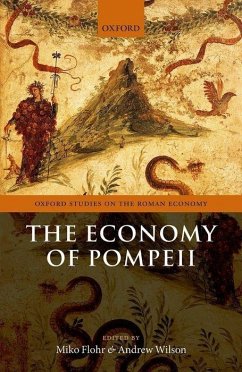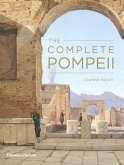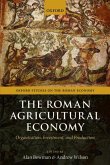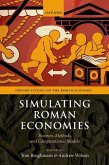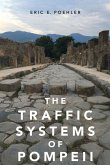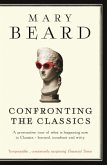The Economy of Pompeii
Herausgeber: Wilson, Andrew; Flohr, Miko
The Economy of Pompeii
Herausgeber: Wilson, Andrew; Flohr, Miko
- Gebundenes Buch
- Merkliste
- Auf die Merkliste
- Bewerten Bewerten
- Teilen
- Produkt teilen
- Produkterinnerung
- Produkterinnerung
This book is the first to address, from a variety of perspectives, the economy of the Roman city of Pompeii. It uses archaeological and textual evidence to discuss topics as diverse as agriculture in the fertile plains at the foot of mount Vesuvius, diet and health, manufacturing, urban investment, consumption, trade and money.
Andere Kunden interessierten sich auch für
![The Complete Pompeii The Complete Pompeii]() Joanne BerryThe Complete Pompeii28,99 €
Joanne BerryThe Complete Pompeii28,99 €![Roman Agricultural Economy Roman Agricultural Economy]() Roman Agricultural Economy54,99 €
Roman Agricultural Economy54,99 €![Simulating Roman Economies Simulating Roman Economies]() Simulating Roman Economies146,99 €
Simulating Roman Economies146,99 €![The Traffic Systems of Pompeii The Traffic Systems of Pompeii]() Eric E. Poehler (Associate Profess Associate Professor of ClassicsThe Traffic Systems of Pompeii47,99 €
Eric E. Poehler (Associate Profess Associate Professor of ClassicsThe Traffic Systems of Pompeii47,99 €![Confronting the Classics Confronting the Classics]() Professor Mary BeardConfronting the Classics15,99 €
Professor Mary BeardConfronting the Classics15,99 €![Doctor Who: The Fires of Pompeii (Target Collection) Doctor Who: The Fires of Pompeii (Target Collection)]() James MoranDoctor Who: The Fires of Pompeii (Target Collection)18,99 €
James MoranDoctor Who: The Fires of Pompeii (Target Collection)18,99 €![Charlie Green and the Gods of Pompeii Charlie Green and the Gods of Pompeii]() Martyn BlundenCharlie Green and the Gods of Pompeii16,99 €
Martyn BlundenCharlie Green and the Gods of Pompeii16,99 €-
-
-
This book is the first to address, from a variety of perspectives, the economy of the Roman city of Pompeii. It uses archaeological and textual evidence to discuss topics as diverse as agriculture in the fertile plains at the foot of mount Vesuvius, diet and health, manufacturing, urban investment, consumption, trade and money.
Hinweis: Dieser Artikel kann nur an eine deutsche Lieferadresse ausgeliefert werden.
Hinweis: Dieser Artikel kann nur an eine deutsche Lieferadresse ausgeliefert werden.
Produktdetails
- Produktdetails
- Oxford Studies on the Roman Economy
- Verlag: Oxford University Press
- Seitenzahl: 452
- Erscheinungstermin: 15. Februar 2017
- Englisch
- Abmessung: 236mm x 160mm x 28mm
- Gewicht: 938g
- ISBN-13: 9780198786573
- ISBN-10: 0198786573
- Artikelnr.: 47869466
- Herstellerkennzeichnung
- Libri GmbH
- Europaallee 1
- 36244 Bad Hersfeld
- gpsr@libri.de
- Oxford Studies on the Roman Economy
- Verlag: Oxford University Press
- Seitenzahl: 452
- Erscheinungstermin: 15. Februar 2017
- Englisch
- Abmessung: 236mm x 160mm x 28mm
- Gewicht: 938g
- ISBN-13: 9780198786573
- ISBN-10: 0198786573
- Artikelnr.: 47869466
- Herstellerkennzeichnung
- Libri GmbH
- Europaallee 1
- 36244 Bad Hersfeld
- gpsr@libri.de
Miko Flohr is postdoctoral researcher and lecturer at the Institute for History of Leiden University, and formerly assistant director of the Oxford Roman Economy Project. His main research focus lies with urban history in the Roman world, with a particular emphasis on economic issues in Roman Italy, and on textile economies. His first monograph, The World of the Fullo, was published with OUP in 2013; since, he has published on the textile economy of Pompeii, and on public investment in commercial space. Andrew Wilson is Professor of the Archaeology of the Roman Empire at All Souls College, University of Oxford. His research interests include the economy of the Roman empire, ancient technology, ancient water supply and usage, Roman North Africa, and archaeological field survey. Recent publications include: Quantifying the Roman Economy: Methods and Problems (ed. with Alan Bowman, Oxford, 2009), Settlement, Urbanization and Population (ed. with Alan Bowman, Oxford, 2011); The Roman Agricultural Economy: Organization, Investment, and Production (ed. with Alan Bowman, Oxford, 2013); Alexandria and the North-Western Delta (ed. with Damian Robinson, Oxford, 2010) and Maritime Archaeology and Ancient Trade in the Mediterranean (ed. with Damian Robinson, Oxford 2011).
* Introduction: Investigating an Urban Economy
* Part I: City and Hinterland
* 1: Girolamo Ferdinando de Simone: The Agricultural Economy of
Pompeii: Surplus and Dependence
* 2: Miko Flohr: Quantifying Pompeii: Population, Inequality, and the
Urban Economy
* Part II: Quality of Life
* 3: Nick M. Ray: Consumer Behaviour in Pompeii: Theory and Evidence
* 4: Erica Rowan: Sewers, Archaeobotany, and Diet at Pompeii and
Herculaneum
* 5: Estelle Lazer: Skeletal Remains and the Health of the Population
at Pompeii
* Part III: Economic Life and its Contexts
* 6: Eric Poehler: Measuring the Movement Economy: A Network Analysis
of Pompeii
* 7: Nicolas Monteix: Urban Production and the Pompeian Economy
* 8: Damian Robinson: Wealthy Entrepreneurs and the Urban Economy:
Insula VI 1 in its Wider Economic Contexts
* 9: Domenico Esposito: The Economics of Pompeian Painting
* Part IV: Money and Trade
* 10: Steven J. R. Ellis: Reevaluating Pompeii's Coin -Finds: Monetary
Transactions and Urban Rubbish in the Retail Economy of an Ancient
City
* 11: Richard Hobbs: Bes, Butting Bulls, and Bars: The Life of Coinage
at Pompeii
* 12: Koenraad Verboven: Currency and Credit in the Bay of Naples in
the First Century ad
* 13: Wim Broekaert: Conflicts, Contract Enforcement, and Business
Communities in the Archive of the Sulpicii
* Part V: Discussion
* 14: Willem Jongman: Pompeii Revisited
* Part I: City and Hinterland
* 1: Girolamo Ferdinando de Simone: The Agricultural Economy of
Pompeii: Surplus and Dependence
* 2: Miko Flohr: Quantifying Pompeii: Population, Inequality, and the
Urban Economy
* Part II: Quality of Life
* 3: Nick M. Ray: Consumer Behaviour in Pompeii: Theory and Evidence
* 4: Erica Rowan: Sewers, Archaeobotany, and Diet at Pompeii and
Herculaneum
* 5: Estelle Lazer: Skeletal Remains and the Health of the Population
at Pompeii
* Part III: Economic Life and its Contexts
* 6: Eric Poehler: Measuring the Movement Economy: A Network Analysis
of Pompeii
* 7: Nicolas Monteix: Urban Production and the Pompeian Economy
* 8: Damian Robinson: Wealthy Entrepreneurs and the Urban Economy:
Insula VI 1 in its Wider Economic Contexts
* 9: Domenico Esposito: The Economics of Pompeian Painting
* Part IV: Money and Trade
* 10: Steven J. R. Ellis: Reevaluating Pompeii's Coin -Finds: Monetary
Transactions and Urban Rubbish in the Retail Economy of an Ancient
City
* 11: Richard Hobbs: Bes, Butting Bulls, and Bars: The Life of Coinage
at Pompeii
* 12: Koenraad Verboven: Currency and Credit in the Bay of Naples in
the First Century ad
* 13: Wim Broekaert: Conflicts, Contract Enforcement, and Business
Communities in the Archive of the Sulpicii
* Part V: Discussion
* 14: Willem Jongman: Pompeii Revisited
* Introduction: Investigating an Urban Economy
* Part I: City and Hinterland
* 1: Girolamo Ferdinando de Simone: The Agricultural Economy of
Pompeii: Surplus and Dependence
* 2: Miko Flohr: Quantifying Pompeii: Population, Inequality, and the
Urban Economy
* Part II: Quality of Life
* 3: Nick M. Ray: Consumer Behaviour in Pompeii: Theory and Evidence
* 4: Erica Rowan: Sewers, Archaeobotany, and Diet at Pompeii and
Herculaneum
* 5: Estelle Lazer: Skeletal Remains and the Health of the Population
at Pompeii
* Part III: Economic Life and its Contexts
* 6: Eric Poehler: Measuring the Movement Economy: A Network Analysis
of Pompeii
* 7: Nicolas Monteix: Urban Production and the Pompeian Economy
* 8: Damian Robinson: Wealthy Entrepreneurs and the Urban Economy:
Insula VI 1 in its Wider Economic Contexts
* 9: Domenico Esposito: The Economics of Pompeian Painting
* Part IV: Money and Trade
* 10: Steven J. R. Ellis: Reevaluating Pompeii's Coin -Finds: Monetary
Transactions and Urban Rubbish in the Retail Economy of an Ancient
City
* 11: Richard Hobbs: Bes, Butting Bulls, and Bars: The Life of Coinage
at Pompeii
* 12: Koenraad Verboven: Currency and Credit in the Bay of Naples in
the First Century ad
* 13: Wim Broekaert: Conflicts, Contract Enforcement, and Business
Communities in the Archive of the Sulpicii
* Part V: Discussion
* 14: Willem Jongman: Pompeii Revisited
* Part I: City and Hinterland
* 1: Girolamo Ferdinando de Simone: The Agricultural Economy of
Pompeii: Surplus and Dependence
* 2: Miko Flohr: Quantifying Pompeii: Population, Inequality, and the
Urban Economy
* Part II: Quality of Life
* 3: Nick M. Ray: Consumer Behaviour in Pompeii: Theory and Evidence
* 4: Erica Rowan: Sewers, Archaeobotany, and Diet at Pompeii and
Herculaneum
* 5: Estelle Lazer: Skeletal Remains and the Health of the Population
at Pompeii
* Part III: Economic Life and its Contexts
* 6: Eric Poehler: Measuring the Movement Economy: A Network Analysis
of Pompeii
* 7: Nicolas Monteix: Urban Production and the Pompeian Economy
* 8: Damian Robinson: Wealthy Entrepreneurs and the Urban Economy:
Insula VI 1 in its Wider Economic Contexts
* 9: Domenico Esposito: The Economics of Pompeian Painting
* Part IV: Money and Trade
* 10: Steven J. R. Ellis: Reevaluating Pompeii's Coin -Finds: Monetary
Transactions and Urban Rubbish in the Retail Economy of an Ancient
City
* 11: Richard Hobbs: Bes, Butting Bulls, and Bars: The Life of Coinage
at Pompeii
* 12: Koenraad Verboven: Currency and Credit in the Bay of Naples in
the First Century ad
* 13: Wim Broekaert: Conflicts, Contract Enforcement, and Business
Communities in the Archive of the Sulpicii
* Part V: Discussion
* 14: Willem Jongman: Pompeii Revisited

